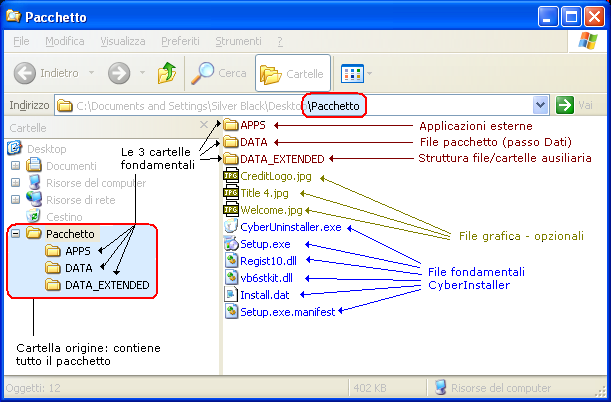![]() CyberInstaller
- 2. Main
file and folder structure required
CyberInstaller
- 2. Main
file and folder structure required
To create a package with CyberInstaller is necessary to place its main files in the right place and create the necessary folders. This is crucial, otherwise you can not run the installation package.

Note: CyberInstaller is
not bootable like any other program and also does not make sense to
start it if it is first created an installation package. Its
main file (Setup.exe)
for, although it can be launched like any other executable will not
work correctly if the installation
script (install.dat) is not properly completed
following the proper syntax, or if the folder structure does not
reflect certain rules.
The core files are CyberInstaller 6 and must be placed at the same level:
|
Filename |
Description |
|
Setup.exe |
executable that starts the process of installing/removing the current package, is the engine installation/removal real |
|
CyberUninstaller.exe |
executable to start the removal process the packet; require any special command line parameters defined during installation |
|
Regist10.dll |
library that allows a registration/deregistration secure file components of the package you need it |
|
Install.dat |
installation
script for the
current packet, to be filled properly |
| Vb6stkit.dll | library for creating links |
| Setup.exe.manifest | manifest file for the use of themes of WindowsXP |
|
Folder name |
Description |
|
APPS |
contains any
applications to run before / after the installation [step
8: "External Applications"] |
| DATE | contains all application files, including support files (components) [step 4 "Data"] |
| DATA_EXTENDED | contains
the whole structure of folders and files to create destination folder (optional)
|
Detailed outline summary of the structure of folders to create:

Note: The creation
of an installation package assumes you've completed your application to
schedule and has therefore available to the compiled executable plus
any supporting files needed
(database, images, sounds, online help, components, libraries etc..),
all preferably in a folder made up. In the
following example schema folder that contains the installation package
- created through CyberInstaller
Studio - is called "package".


Note:
To
avoid having to manually perform these tedious, it is highly
recommended (though not essential) to use CyberInstaller
Studio, which through an easy interface to walk,
will create the installation package and all the technical details in
our place , in a completely automatic, transparent, and minimizing the
possibility of error. The use of CyberInstaller
Studio is also essential for the
creation of the self-extracting
executable package.
![]() See
also ...
See
also ...